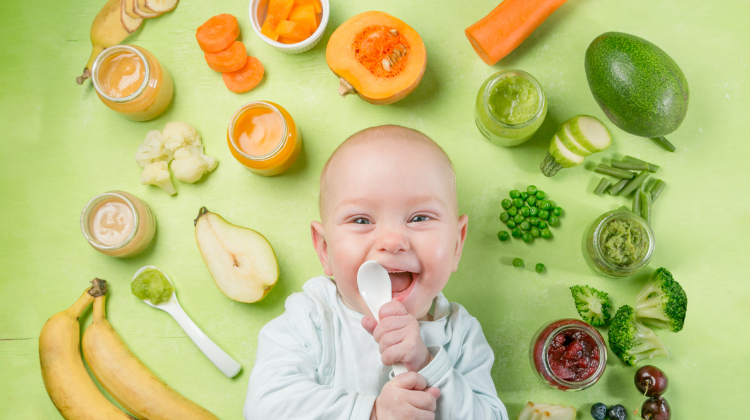Healthy Foods to Help Babies & Toddlers Gain Weight (0 To 3 Years) In 2024

Parents should closely monitor their baby’s weight[1] because it is a marker of general health. Babies are born weighing around 6-9 lbs; however, the infant’s weight is affected by gender, maternal nutrition, initial birth weight, the baby’s diet, and so on.
Some babies are born underweight or their weight gain is slower than babies of their age group. To support a healthy weight gain, you should give nutritious foods that meet your baby’s needs. That’s why it is crucial to know healthy foods to help your baby gain weight.
What Are Best Foods for Weight Gain in Babies and Toddlers?
1. Foods To Help Baby Gain Weight Between 6-11 Months:
- Avocado
- Pulses
- Meat
- Eggs
2. Foods To Help Toddlers Gain Weight After 12 Months:
- Fish
- Cow’s Milk
Best Foods for Weight Gain in Babies and Toddlers
If the high-calorie foods are also nutrient-rich, you can consider them healthy weight-gaining foods. Here are wholesome foods for babies that may boost weight gain.
Foods to Help Baby Gain Weight Between 6-11 Months
Avocado
Although you should serve a variety of fruits to provide different nutrients, avocado[2] is one of the most energy-dense fruits containing healthy fats. It has two times more energy and protein than bananas[3] or pears[4] contain.
For a 6-8-months-old baby[5], you can mash or purée 2-3 tablespoons of avocado; for a 9-1- months-old baby, you can chop or mash half of a cup of avocado.
Pulses
Pulses are the edible seeds of legumes–beans, lentils, and peanuts, plant-based sources of protein that contain a good amount of fiber and some iron.
You can cook, grind or mash pulses and even mix them with breast milk or formula to make them smoother.
Another great way to increase healthy calories is to add olive oil to a meal. A 6-month-old baby can eat up to 10g of olive oil[6] daily.
Meat
Meat is an excellent source of protein, iron, and vitamin B12. For a 6-month-old baby, you can cook about 15 mg-strips of meat[6].
A 1-year-old infant can eat 30g of meat with a side dish like rice or broccoli. Meat should be boneless[7] and you should remove all fat and skin.
Eggs
Eggs are the highest quality protein[8] and are rich in healthy fats, protein, iron, vitamin A, vitamin B12, vitamin D, and more.
You can make egg fingers[9] from half an egg. Boil the eggs, peel, slide, and the nutrient-rich meal is ready. Or you can scramble eggs (half an egg) with a little milk and olive oil.
Other foods such as sweet potatoes and nut butter are great for a calorie boost.
Foods to Help Toddlers Gain Weight After 12 Months
Your baby should already be eating meat, fish, poultry, egg, dairy products, grains, legumes, fruits, and vegetables. After one year, new foods are waiting to be added to a child’s diet.
Here are new high-calorie foods for toddlers:
Fish
Fish is one of the high-fat foods for toddlers. At the same time, it is a quality protein source containing omega-3, iron, zinc, and vitamin B12. It is also one of few foods that contain vitamin D, important in climates that don’t have a lot of sunshine. Most importantly, fish supports a child’s immune system and brain development.
According to the Food and Drug Administration (FDA)[10], children between 1-3 years are advised to eat 1 ounce of low-mercury fish.
Cow’s Milk
After 12 months, your toddler can drink whole cow’s milk[11] as their main drink. Whole milk and full-fat dairy products such as full-fat yogurt are rich in calcium and phosphorus, which support healthy bones and teeth. Full-fat milk and whole milk yogurt contain a good amount of vitamin A for healthy eyes and skin.
Babies older than 12 months can eat almost any foods to which they are not allergic. Preparing nutritious meals with various foods may encourage weight gain when babies get more active after 1 year. Examples[12] of meals that may help your child gain weight are
- Breakfast: a bowl of porridge with fruits or a great trio, e.g., with slices of bread, hard-boiled egg, and various veggies
- Lunch or dinner: noodles with chicken and green leafy vegetables or soup with butternut squash, lentils, and red pepper
- Snacks: yogurt with various fruits or hard-boiled eggs to dip in a sauce made of smashed avocado and cream cheese
You can visit the NHS page[12] for more recipes and meal ideas for your baby.
How to Increase Weight in Babies & Toddlers
According to the UK National Health Service (NHS)[13], gradual weight gain means that your baby is feeding well and healthy. Keep in mind that babies born outside the official growth-rate “range” also can be completely healthy.
How Do You Know If Your Baby’s Body Weight Is in the Healthy Range
You don’t need to weigh your baby daily. 2 weeks after birth, you are recommended to weigh your baby
- Once a month during the first six months
- Once every two months between 6-12 months
- Once every three months after one year
You weigh your baby; well done. How do you know if your child’s weight is in the healthy range? You should check your baby’s weight gain with an age chart that indicates optimum growth. Your pediatrician can show you your child’s charts.
The growth chart gives you which percentile your baby’s height and weight lie in, based on gender. 99% of babies growing optimally have their height and weight marks between the lines which identify the range between 0.4th and 99.6th “centiles”[14] (percentiles).
Remember, babies grow at different rates, so the centile/percentile of your baby may change from time to time, especially in the first year.
Babies gain weight at different rates depending on their feeding methods. The World Health Organization (WHO) considers such feeding methods in growth charts[15]. Because healthy babies fed with only breast milk typically gain weight more slowly, especially in the first year.
If you wonder how to make your baby gain weight fast, try not to worry about the time involved. Make sure you feed your baby at the appropriate frequency and volume and, if there are any remaining concerns, let your pediatrician or family doctor make the call.
Slow Weight Gain in Babies
Slow weight gain is not always a health problem. Some babies are naturally smaller than others. However, there could be medical conditions behind slow weight gain. If you’re worried that your child has a medical condition affecting their weight and health, you should see a doctor.
Treatment of slow weight gain changes based on the reason behind the condition. If the cause is poor nutrition, you should see a doctor and a dietitian to get a nutrition plan. Alternatively, your child may have digestive issues or allergies that inhibit weight gain.
Choosing nutrient-rich and healthy food that is high in energy may help babies to put on weight and stay healthy.
Feeding the Baby Under 6 Months
Babies are fed breastmilk and/or formula milk and do not need complementary food before 6 months. You should breastfeed[16] your baby every 2 to 4 hours, fine-tuned by your baby’s individual quirks.
If your infant is formula-fed[17], you can give 1 to 2 ounces of infant formula at 2-3 hours intervals. If you only provide formula milk, you can give more if they are still hungry.
Feeding 6-to-11-Months Baby
The WHO recommends exclusively breastfeeding until your baby is six months old. Then complementary feeding should be introduced between 17 to 26 weeks. As you know, not all food can be given at first.
According to the European Food Safety Authority (EFSA), a few important things to consider when choosing and preparing[18] baby food:
- Foods for babies should be in an age-appropriate texture to avoid choking. You can give puréed, mashed, or semi-solid baby food at the beginning
- After the age of 8 months, infants can eat finger foods
- You should avoid sugar, salt, and unmodified cow’s milk (milk they’re not prepared to digest yet)
- You should follow good hygiene to reduce infection risks
The EFSA stated that you don’t have to wait to introduce other complementary foods to introduce allergen foods such as eggs, cereals, peanuts, and fish because the risk of developing an allergy would not change whether or not you introduce it at a later age.
The WHO[19] recommends feeding babies with complementary foods 2-3 times a day between 6-8 months and 3-4 times between 9-11 months. Some baby foods to help infants gain weight:
- Infant cereals fortified with iron and zinc
- Grains such as whole grain bread and pasta
- Fruits such as bananas, oranges, pears, avocados, strawberries, and melons–you can choose local and seasonal fruits
- Vegetables
- Various protein sources[20] such as soft and small pieces of beef, lamb, turkey, chicken, and eggs
- Pasteurized yogurt and cheese as greater protein and calcium sources
Feeding a Toddler After 12 Months
A 12-month-old baby can eat almost everything the family members eat, assuming the family eats healthy and balanced meals. However, babies should not be given processed foods that increase caloric intake but have no nutritional benefits, such as junk food.
Sugar and sugary drinks are energy dense, but either they don’t contain any other nutrients or they contain very little.
Thus, soda, juice drinks, fruit drinks, or fruit-flavored drinks contain sugar and should be avoided. Only 100% juice[21] can be drunk by babies older than 12 months, so don’t forget to check the label for ingredients.
The Bottom Line
Little one’s diet can significantly impact their weight. Providing a balanced diet may support the baby’s growth and healthy weight gain.
Before six months, your baby should be fed breast milk and/or formula. What you can do is provide feeding frequency and volume matching your baby’s calorie and nutrient needs.
After six months, you should introduce semi-solid–and then solid foods–that help them gain weight. Weight-gaining food which you can give at 6-12 months could be avocado, meats, pulses, eggs, sweet potato, nut butter, or cream cheese.
After one year, you can give fish and cow’s milk, too. Before that, unmodified cow’s milk is not well-digested. From one year on, your toddler can eat many foods that family members eat.
However, keep your toddler away from processed foods high in saturated fat and sugar. As always, beware of choking portions if they’re sharing adult meals.
If you are worried about your baby’s slow weight gain or don’t know how to have your toddler gain weight, you should see a doctor and dietitian get an appropriate treatment and nutrition plan.
+ 21 sources
Health Canal avoids using tertiary references. We have strict sourcing guidelines and rely on peer-reviewed studies, academic researches from medical associations and institutions. To ensure the accuracy of articles in Health Canal, you can read more about the editorial process here
- American Pregnancy Association. (2012). Average Newborn Weight. [online] Available at: https://americanpregnancy.org/healthy-pregnancy/first-year-of-life/newborn-weight-gain/
- Usda.gov. (2022). FoodData Central. [online] Available at: https://fdc.nal.usda.gov/fdc-app.html#/food-details/171705/nutrients
- Usda.gov. (2022). FoodData Central. [online] Available at: https://fdc.nal.usda.gov/fdc-app.html#/food-details/173944/nutrients
- Usda.gov. (2022). FoodData Central. [online] Available at: https://fdc.nal.usda.gov/fdc-app.html#/food-details/169118/nutrients
- Nih.gov. (2022). TABLE 1, Practical guidance on the quality, frequency and amount of food to offer children 6–23 months of age who are breastfed on demand. [online] Available at: https://www.ncbi.nlm.nih.gov/books/NBK148957/table/session3.t1/?report=objectonly
- D’Auria, E., Borsani, B., Pendezza, E., Bosetti, A., Paradiso, L., Zuccotti, G.V. and Verduci, E. (2020). Complementary Feeding: Pitfalls for Health Outcomes. International Journal of Environmental Research and Public Health, [online] 17(21), p.7931. doi:10.3390/ijerph17217931.
- CDC (2021). When, What, and How to Introduce Solid Foods. [online] Centers for Disease Control and Prevention. Available at: https://www.cdc.gov/nutrition/infantandtoddlernutrition/foods-and-drinks/when-to-introduce-solid-foods.html
- Hoffman, J.R. and Falvo, M.J. (2004). Protein – Which is Best? Journal of sports science & medicine, [online] 3(3), pp.118–30. Available at: https://www.ncbi.nlm.nih.gov/pmc/articles/PMC3905294/#:~:text=as%20animal%20proteins.-,Animal%20Protein,of%20proteins%20from%20these%20sources.
- NHS Choices (2022). Egg fingers. [online] Available at: https://www.nhs.uk/start4life/weaning/recipes-and-meal-ideas/egg-fingers/
- Center (2022). Advice About Eating Fish. [online] U.S. Food and Drug Administration. Available at: https://www.fda.gov/food/consumers/advice-about-eating-fish
- NHS Choices (2022). What to feed young children. [online] Available at: https://www.nhs.uk/conditions/baby/weaning-and-feeding/what-to-feed-young-children/
- NHS Choices (2022). Recipes and meal ideas. [online] Available at: https://www.nhs.uk/start4life/weaning/recipes-and-meal-ideas/
- NHS Choices (2022). Your baby’s weight and height. [online] Available at: https://www.nhs.uk/conditions/baby/babys-development/height-weight-and-reviews/baby-height-and-weight/
- Department of Health (2009). BOYS UK–WHO Growth Chart 0–4 years. [online] Available at: https://www.rcpch.ac.uk/sites/default/files/Boys_0-4_years_growth_chart.pdf
- CDC (2022). Breastfeeding as the Norm. [online] Centers for Disease Control and Prevention. Available at: https://www.cdc.gov/nccdphp/dnpao/growthcharts/who/breastfeeding/index.htm
- CDC (2022). How Much and How Often to Breastfeed. [online] Centers for Disease Control and Prevention. Available at: https://www.cdc.gov/nutrition/infantandtoddlernutrition/breastfeeding/how-much-and-how-often.html#:~:text=Over%20the%20first%20few%20weeks,of%204%20to%205%20hours.
- CDC (2022). How Much and How Often to Feed Infant Formula. [online] Centers for Disease Control and Prevention. Available at: https://www.cdc.gov/nutrition/infantandtoddlernutrition/formula-feeding/how-much-how-often.html
- European Food Safety Authority. (2019). Age to start complementary feeding of infants. [online] Available at: https://www.efsa.europa.eu/en/news/age-start-complementary-feeding-infants
- World (2019). Complementary feeding. [online] Who.int. Available at: https://www.who.int/health-topics/complementary-feeding#tab=tab_2
- CDC (2022). Foods and Drinks to Encourage. [online] Centers for Disease Control and Prevention. Available at: https://www.cdc.gov/nutrition/infantandtoddlernutrition/foods-and-drinks/foods-and-drinks-to-encourage.html
- CDC (2022). FAQs. [online] Centers for Disease Control and Prevention. Available at: https://www.cdc.gov/nutrition/infantandtoddlernutrition/faqs.html



